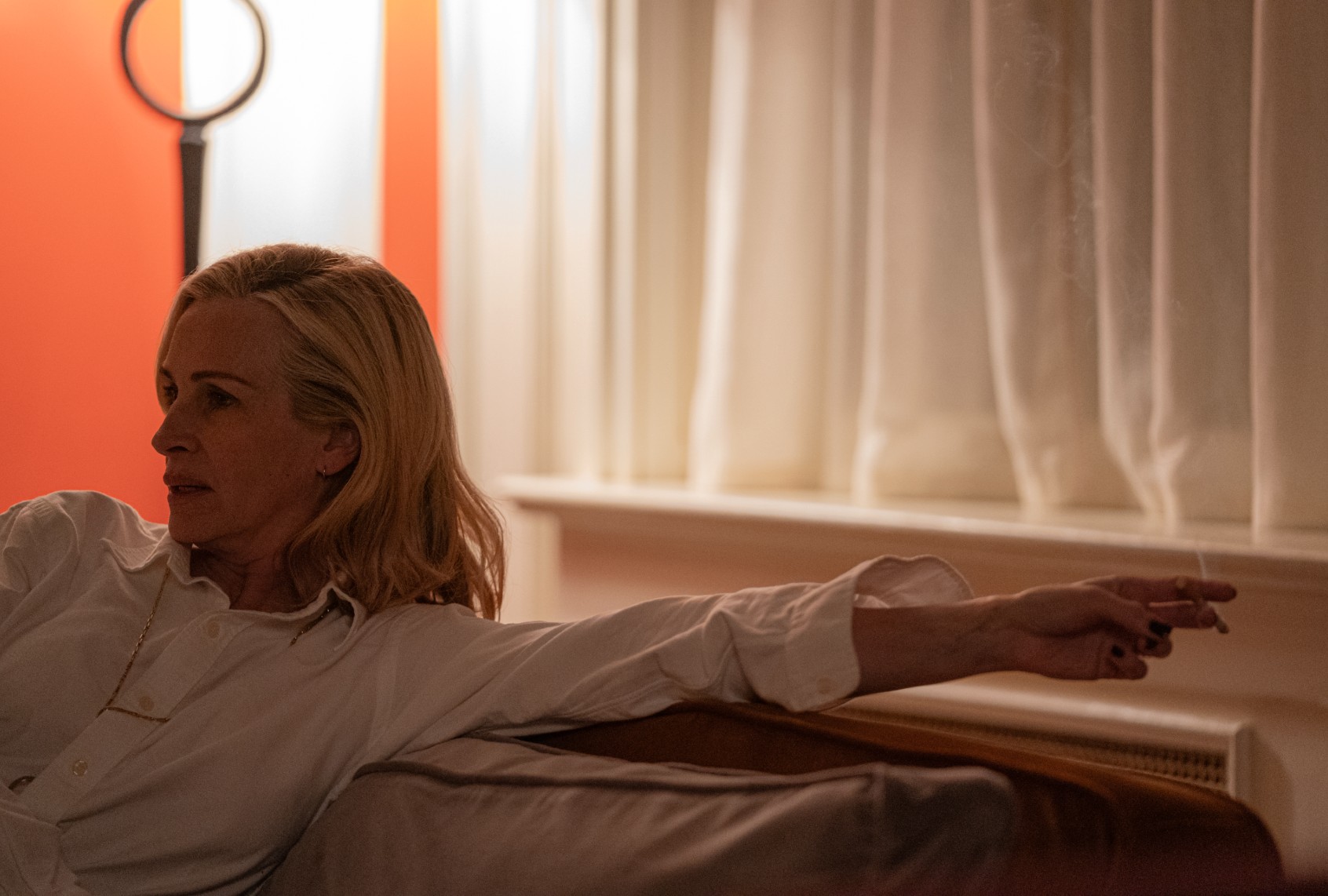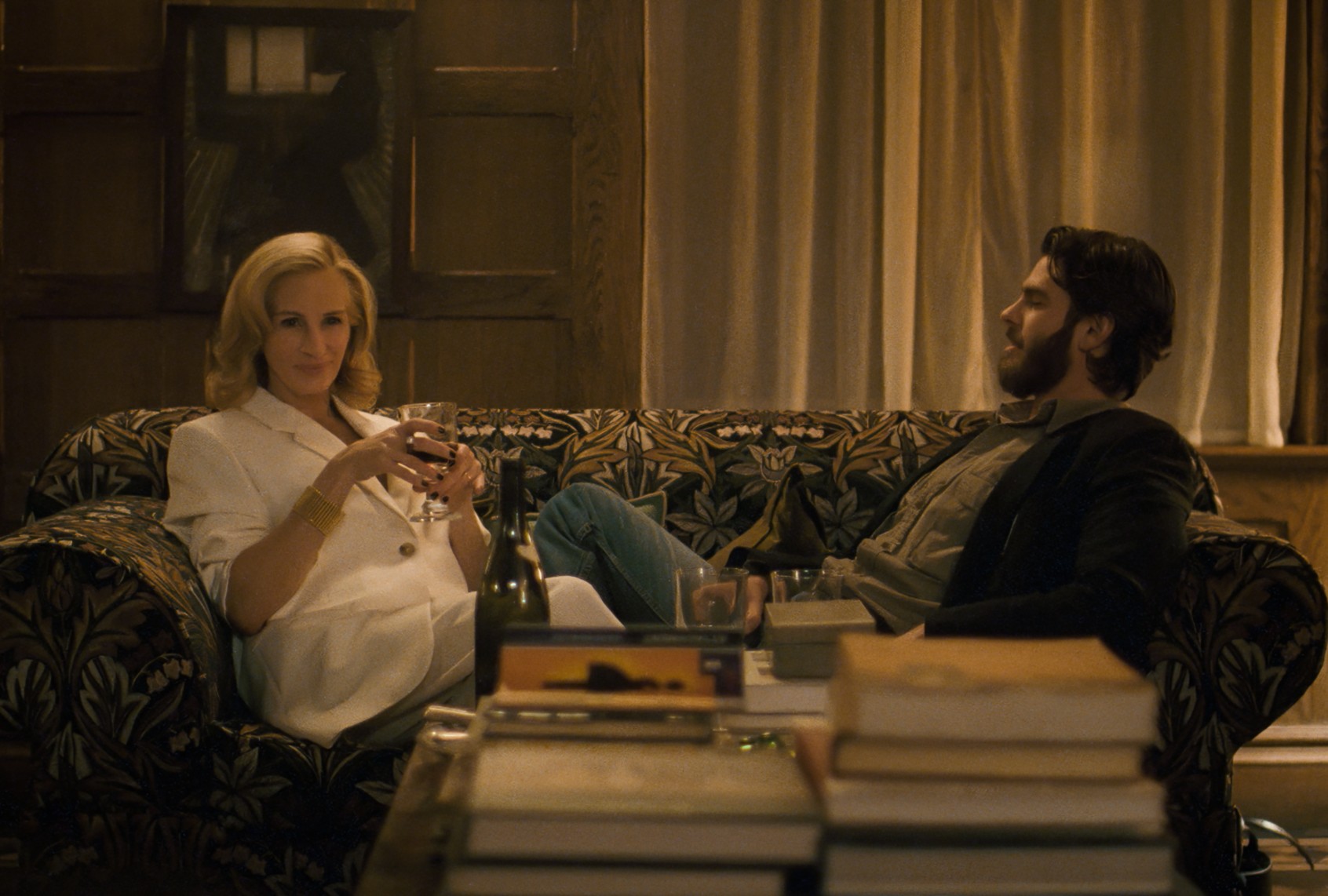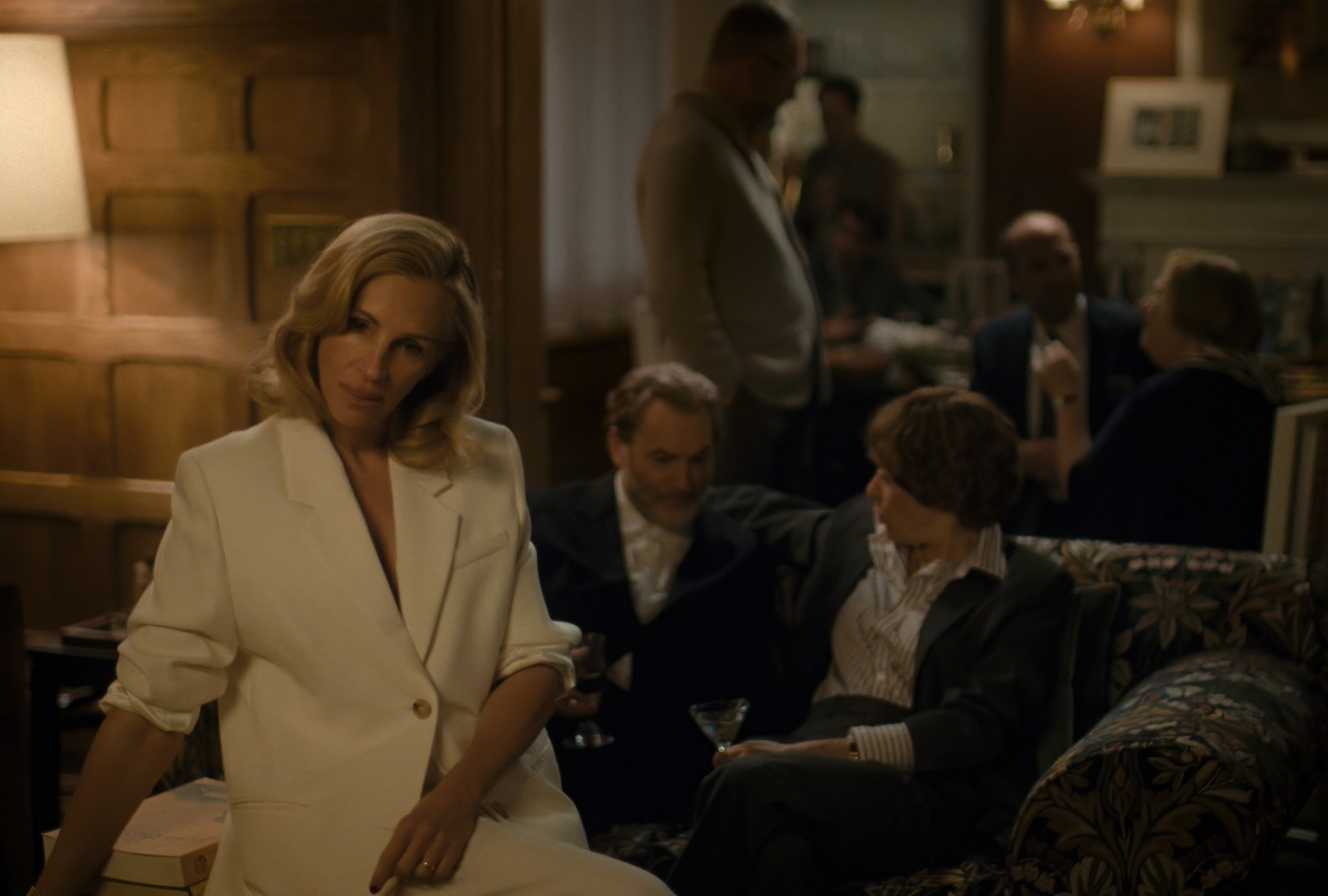In what seem like pivotal moments during director Luca Guadagnino’s new film, “After the Hunt,” conversations between characters are all but drowned out by music. Tense discussions of life-altering events are matched by the diegetic decibels of smooth jazz or string symphonies. Elsewhere, the audio drops out completely, replaced by the noise of a ticking clock that lingers just long enough to make the viewer squirm in their seat. And sometimes, an otherwise unexceptional sequence in the film is interrupted by a discordant two-note sucker punch; a jumpscare with no scare, courtesy of Trent Reznor and Atticus Ross’ typically superb score, signaling a shift in the swirling power dynamics at play. It doesn’t totally matter what a character is saying or doing in these moments, because their interior motives are not up for debate or conversation. These people might look like they’re conversing, having lively battles of collegiate wit, stereotypical of an Ivy League institution. But really, every last one of these characters is unchanging in their values, steadfast players in a game that has multiple possible outcomes, but only one winner.
Built upon a chimeric screenplay from first-time screenwriter Nora Garrett, “After the Hunt,” which opens the New York Film Festival this week and lands in theaters nationwide Oct. 17, bravely tunnels to the core of our collective distrust in our fellow humans and lights a stick of dynamite. And across the 138 frustrating, fascinating minutes that follow, audiences are charged with watching the shrapnel fall, eyes darting between each piece as it plummets to the ground, trying to get a good enough look to put something cohesive back together from the wreckage. Guadagnino and Garrett both understand this is an impossible task, but that’s what makes “After the Hunt” such a remarkable cinematic experience: An integral piece of the puzzle will always be buried in the dirt somewhere, and without a complete picture, any one viewer may have a different, justifiable view of the fragmented final image. Guadagnino’s most star-studded film yet is also his most mercurial, and Garrett’s brilliant script intentionally plays with the audience’s perception to hyperanalyze a world where truth has become conceptual. This is a film that won’t be for everyone, a movie that will cause discourse, disagreements and a whole lot of distaste. What could be more fun than that?

(Amazon MGM Studios) Julia Roberts as Alma Olsson in “After the Hunt”
It’s not that Garrett is questioning survivors; rather, she’s examining all sides of a campaign for justice, and scrutinizing the cracks in our culture’s response to assault, recesses where ill-intentioned agitators can make themselves comfortable.
All that debate certainly seems like part of the point, given that “After the Hunt” focuses on the fallout of a psychoanalytical triangle between three figures in Yale’s psychology department: Two professors, Alma (Julia Roberts) and Hank (Andrew Garfield), and their student, Maggie (Ayo Edebiri). Despite being more than a decade their junior, Maggie is inducted into Alma and Hank’s circle of hifalutin intellectuals, gathering at Alma’s stunning apartment for academic salons where philosophical ideas are batted back and forth like squash balls between red wine and berry tarts. The line between instructor and student is blurred from the start of the film, something Alma doesn’t seem to mind as Maggie slots herself comfortably into the role of her favorite professor’s protege. The two women are so close that Maggie has even taken to dressing a bit like Alma and painting her nails the same jet black color. Or, is it the other way around, and Alma has started to pick up Maggie’s habits? The origin of their freaky symbiosis is never quite clear, exactly as Garrett wants it to be.
When Hank offers to walk Maggie home after the party, it doesn’t take a tenured Ivy professor to guess what will happen next. We’ve seen enough plays, read enough books and watched enough movies — hell, we’ve lived in the real world long enough — to know where this story is headed. The following evening, Maggie shows up at Alma’s door, recounting the story of the night before in vague detail. Alma, however, insists on absolute clarity, a transparency she’s not afforded. “Hank crossed a line,” Maggie insists. But already, Alma’s slight hesitation is enough to sow doubt about the closeness of their relationship. When Maggie makes an ambiguous reference to Alma’s history, her professor recoils. Where Maggie is candid, at least to a point, Alma is a steel trap. Sitting on the dusty steps of a New Haven apartment building, the generational divide suddenly looks a lot more like a wall, one that’s fortified to separate these two women for good.
It’s here where “After the Hunt” succeeds where so many films have stumbled. Unlike contemporaries such as “Eddington” or the otherwise fantastic “One Battle After Another,” Guadagnino’s film doesn’t get mired in the tired, hacky jabs at millennials and Gen Z. Make no mistake: Garrett hurls some truly nasty, bold barbs at the 20-and-30-something crowd, but her riffs on safe spaces and pronouns are written with a clever nuance that fits the film’s spiky narrative, instead of being played for cheap laughs. In its depiction of a mobilized youth culture, “After the Hunt” audaciously reminds the viewer that every generation has its bad actors, those who are looking to co-opt a movement and its views for their own gain. Garrett then takes one major step further, looking at the sickly side of modernity through the lens of the MeToo movement. It’s not that Garrett is questioning survivors; rather, she’s examining all sides of a campaign for justice, and scrutinizing the cracks in our culture’s response to assault, recesses where ill-intentioned agitators can make themselves comfortable.

(Amazon MGM Studios) Julia Roberts as Alma Olsson and Andrew Garfield as Henrik “Hank” Gibson in “After the Hunt”
Roberts isn’t just chewing the scenery; she’s devouring the celluloid and licking her chops, hungry for more.
A film like this could only be possible with some distance from the 2017 onset of MeToo, when for a few brief, shining months, it actually looked like violent assailants might get their just desserts and be forced to take accountability. Yet, aside from Harvey Weinstein, it’s difficult to conjure many names in popular culture that actually faced any tangible consequences. Take Donald Trump, who was found liable for sexual abuse and defamation against E. Jean Carroll in 2023, just one of the laundry list of allegations lodged against the president over the last decade. A year later, Trump still managed to win the popular vote, scoring a second term of his presidency. Even when credible accusations are made and civil lawsuits are filed, the evidence isn’t enough to generate repercussions. And when Maggie decides to press charges against Hank and tell her story to the press, the fallout unsurprisingly does not seem great enough. What’s more, Maggie wants a companion in her quest for justice, someone to validate her in a way that no juicy Rolling Stone headline can — someone like Alma, whose mysterious past seems to correlate with the chaotic present. The only problem is that Alma has no interest in being that source of validation.
Start your day with essential news from Salon.
Sign up for our free morning newsletter, Crash Course.
As Alma reconciles this moral tug of war she’s found herself in, Roberts digs her nails into the opportunity of a lifetime, taking on the role of an unlikeable, power-hungry, exasperated woman on the verge with delectable aplomb. While Garfield and Edebiri more than hold their own — alongside fantastic supporting bits from a bewigged Chloë Sevigny and cassoulet-loving Michael Stuhlbarg — “After the Hunt” is Roberts’ show, and what a grand spectacle it is. Roberts isn’t just chewing the scenery; she’s devouring the celluloid and licking her chops, hungry for more. Alma’s constant volatility is balanced by Roberts’ sympathetic, multilayered performance, and watching her is akin to putting a plastic child safety cover into an outlet, only for that outlet to spit it right back out, crackling with electric intensity. The solution isn’t to try putting the cover back on; it’s to get the hell away from the outlet entirely. Multiple sequences are career standouts, but I can’t think of anything more definitive than the seesawing masterwork between Alma’s end-of-her-rope blowup at a student in her psychology text close-reading and a frightening, tender monologue she delivers to Stuhlbarg as the action is winding down in the film’s final act.
It’s that section of the film where Guadagnino and Garrett task viewers with showing their work, where they must display whether or not they were able to trace a sense of cohesion and concrete meaning to this chamber play. Who are the winners, who are the losers, and what have we learned, kids? And, like any college-level debate, are those findings really the whole truth? In the end, Guadagnino takes a jackhammer to everything he’s spent the last two-plus hours so meticulously building, but not quite in the way one might expect. What transpires is simply another line of questioning, like finally completing a 1,000-piece puzzle, only to somehow find another piece sitting under the instructions in the box. Maybe it’s not just what happens after the hunt that matters, but what happens to the trophies the hunter has collected in their efforts — deer heads that sit gathering dust in a garish den, or golden trophies that have their repute fade over time. All the strain and ruin and destruction that it took to amass some form of fleeting power, the arguments that transpired in its pursuit; none of it was anything more than another dividing line, drawn in permanent ink. There will always be more questions than answers to how we came to this place. And perhaps it’s not the definitive truth we should be seeking, but rather, an acceptance that such a thing can never exist.
Read more
about this topic


